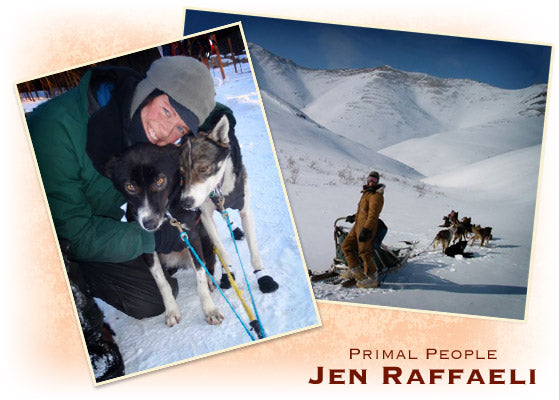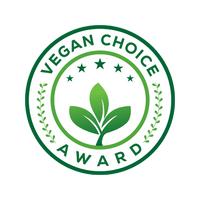
Jen Raffaeli
"Up in Alaska it can be hard to find good vegetarian protein sources. Primal Strips are the perfect snack for me on long training runs and races with the dogs. I love dog mushing because it allows me to nurture the "primal spirit" of the sled dogs and through them I discover my own spirit as we travel thousands of miles together in the frozen north. Primal Strips give me the nutrition and energy I need to keep going in a delicious little package."
I run dogs because I love dogs, I love to be out there with them witnessing and being a part of their legacy in the north. My days are filled with caring for dogs and the rewards are well worth the long hours of hard work.
How does training work?
When puppies are born (most often during the summer) they live in a big pen with mom and their siblings. When they are big enough we start taking them on loose walks out from the dogyard. Mom and the old dogs and Ken & Gwen's family pet dog go along as trainers/ supervisors. The puppies learn to be brave and explore and have fun on the trail. They also learn to listen to us when we call them back (we use a can of kibble to shake and when they come back they get a kibble reward). They work their way up to a 3 mile walk as many days a week as we can go their first winter. In the spring they learn to wear harnesses and do that same 3 mile loop pulling a sled. Its a lot of stopping and petting them and making sure they are having fun - all positive training. They get the summer off from pulling a sled as it is generally too hot. Training starts again in the fall with 3 miles and building up from there as they are physically and mentally ready to go longer. Any musher will tell you, you cannot force a dog to run. These guys run because they LOVE to run. When we start hooking up a team they dogyard goes nuts with everyone running around and barking and trying to get picked for the team. Any dogs left behind will often let out a sad howl after the team leaves. Think about retreivers, german shepards, etc. They are bred to want to do certain tasks - huskies are bred to want to run and pull a sled, it makes them happy. The kennels allow them to run in teams with mothers and children together, siblings together, etc. They have their family unit structure in place unlike a house pet who often only has human companions. It is fun to see dogs interacting in their social units.

What happens when a dog gets hurt?
During training runs and races we are constantly watching for changes in gait. If you notice a dog start to run funny you go up and check paws, wrists, shoulders, etc. to see if the dog has an injury. If so, you load it into the sled bag on a soft jacket and secure it so it doesn't try to jump back out (often the dogs don't want to stop running). When you get home its a lot of physical therapy just like with people - alternating ice and heat and wrapping with a special liniment (peanut oil and rosemary) to help reduce swelling and speed up healing. The dog will not run for a week or two or more until it has recovered completely. THen you will start it up on shorter runs and rebuild it back to the higher mileage.
What happens to dogs that no longer race?
They retire somewhere between 6-9 years old from racing usually. Some lead dogs will continue to run with the yearling teams to help train the youngsters at the shorter miles. Some will get adopted to families with recreational kennels that want a sled dog for their team. The rest stay here in the kennel and run around free doing whatever they please all day including going on walks with puppies, hanging out by the woodstove in the cabin with us at night, sitting in the sun, etc. Its a pretty relaxing retirement. They'll often live to be 12-14 years old.
How are the dogs cared for?
Each dog lives in a wooden house filled with straw. Straw is an excellent insulator as it creates warm air space. Its also a great way for the dogs to clean off and stay dry. We replace the straw every few weeks as needed. The dogs all know their houses. We let them run loose after the runs and then call them back to their houses where they rest/ sleep for the rest of the day. People ask why the dogs are each on their own chain? These dogs are not all spayed or neutered because mushers want to breed their best dogs for future race teams. We want to be in charge of the breeding program and not leave it up to the dogs. The females in heat have their own separate pen with a tall fence around it so if a male does get loose or a dog from another kennel wanders in they can't accidentally breed a dog.
We feed the dogs twice a day and really focus on keeping them hydrated by soaking the kibble in broth. The racing team gets lots of nutritional supplements to meet their high energy needs. We scoop poop every day and keep the kennel very clean.
How are the dogs cared for on the race trail?
There is straw provided at every checkpoint for mushers to put out for dogs to sleep on. We also carry straw in the sled to put out if we are going to camp on the trail for a few hours. Some mushers also put fleece blankets on their dogs to keep them extra warm. The dogs have different types of jackets they can wear to protect them from different weather conditions and booties to protect their feet as well as special ointments the mushers will put in every paw at every major rest. The conservative schedule I will be running is to go about 5-6 hours on the trail and then rest for an equal amount of time. The dogs get snacks every few hours during the run and then a soaked kibble meal and more snacks during every rest. There are veterinarians at checkpoints and dog drops to examine the dogs and discuss with mushers if there are any concerns about a dog's health or ability to continue. If a dog cannot go on you "drop" the dog and your handler (support crew) will take care of the dog for the rest of the race. You start with 14 dogs and can finish with no less than 6. You cannot add in any new dogs.
Smiles,
Jen Raffaeli










